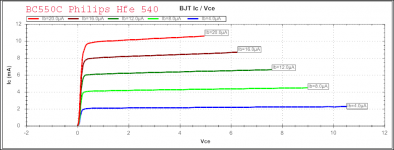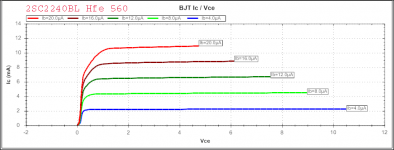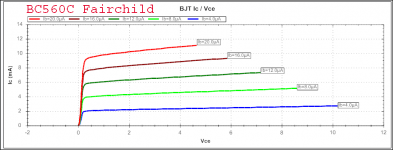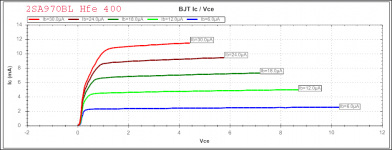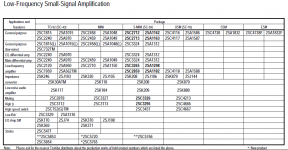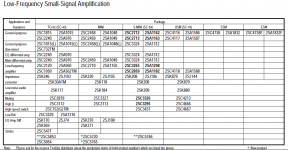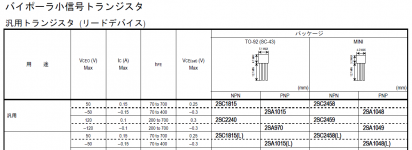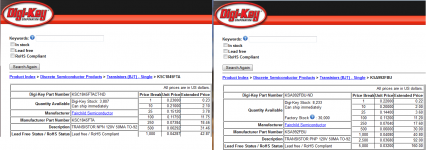I think the 2SC3324 is the SMT version of that part Dale
The datasheet power dissipation spec for the 2SC2240 TO-92 is 300mW.
The datasheet power dissipation spec for the 2SC3324 SMT is 150mW.
It is probably worth the extra trouble and cost to find some NOS of 2SC2240 BL.
Perhaps the diyAudio Krell KSAxx Klone threads would have vendor info.
That difference is due to the device packaging, not the internal silicon die itself. In a particular circuit application the power dissipation capability may indeed be a dominant factor for device selection. For a small-signal stage where idle current is a few mA and collector-emitter voltage only a dozen volts or so, the SMT part is an easy electrical substitution for the thru-hole version. (The mechanical and physical fit is, of course, more problematical.)The datasheet power dissipation spec for the 2SC2240 TO-92 is 300mW.
The datasheet power dissipation spec for the 2SC3324 SMT is 150mW.
Where higher power dissipation is a legitimate requirement, such as a predriver, the low noise and high gain of the 2SC2240 are typically less critical and other TO-92 devices - even though electrically dissimilar to the 2SC2240 - are good candidates for substitution.
In the larger scope of things, I don't think the advice to "buy up the NOS wherever you can find it" really solves the problem. The original request to identify a current production part, even if using it requires some modifications, strikes me as the wiser approach.
Dale
Dale
I did not have a 546C handy, but here is a 550C Philips and a Toshiba C2240BL.
Plus a 560C & A970BL. The A970BL shows ~same Early to its complementary nonetheless. (The BCs have 3-4 times the 2SC's-2SA's Rbb' which matters only in low noise applications).
Plus a 560C & A970BL. The A970BL shows ~same Early to its complementary nonetheless. (The BCs have 3-4 times the 2SC's-2SA's Rbb' which matters only in low noise applications).
Attachments
Ampslab have guaranteed originals (2SC2240) . Have a look here: Original Small Signal Audio Bipolar Transistors - Buy OnLine @ AmpsLab
2SC2240: --> 2SC2459 2SC3324
Hi,
Here's an extract from an old TOSHIBA Small Signal Transistor data book:
Having worked in Japan for 5 years, there really are no western equivalents, in TO-92 (or SC-43 as the Japanese refer to them) hole through packages to the discontinued TOSHIBA or HITACHI/RENESAS BJTs with low noise and low Rbb.
I would love to find an equivalent to the Renesas 2SC2547-D, aside from low noise, low Cob and an Rbb in the region of 12.5 ohms, there is no other device from the likes of ON, Fairchild or NXP.
Renesas killed off their small-signal hole through parts after they nearly hit the wall in 2008. They did hit the wall in 2012 - these guys couldn't market themselves out of a wet paper bag!
I have used BC338-40, the Rbb circa 30 ohm, so need at least two in parallel (better than BC550C @ around 150 ohm), noise characteristics and input capacitance are not too removed from those of the 2SC2240-GR, however the voltage and current characteristics are quite different along with Cob etc
I'd like to replace the 2sc2240 BL differential pairs in the driver board of an Adcom GFA-555. These are getting pretty scarce and i'll need quite a few to find some that are close.
Can someone suggest a current production equivalent?
Hi,
Here's an extract from an old TOSHIBA Small Signal Transistor data book:
Having worked in Japan for 5 years, there really are no western equivalents, in TO-92 (or SC-43 as the Japanese refer to them) hole through packages to the discontinued TOSHIBA or HITACHI/RENESAS BJTs with low noise and low Rbb.
I would love to find an equivalent to the Renesas 2SC2547-D, aside from low noise, low Cob and an Rbb in the region of 12.5 ohms, there is no other device from the likes of ON, Fairchild or NXP.
Renesas killed off their small-signal hole through parts after they nearly hit the wall in 2008. They did hit the wall in 2012 - these guys couldn't market themselves out of a wet paper bag!
I have used BC338-40, the Rbb circa 30 ohm, so need at least two in parallel (better than BC550C @ around 150 ohm), noise characteristics and input capacitance are not too removed from those of the 2SC2240-GR, however the voltage and current characteristics are quite different along with Cob etc
Attachments
Last edited:
toshiba databook extract
Here's the extract:
If Ic is not a key factor, KSC1845-F and KSA992-F are often overlooked by many, aside from half the Ic of the 2SC2240 - these parts work as near direct replacement for the 2SC2240 and 2SA970.
I was told these parts were developed by Samsung when they owned Luxman back in the late 90's. I understand Fairchild acquired Samsung's SEC division fab and discrete semiconductor components business.
The KSC1845 is kind of interesting as it's almost a half-way house between the brilliant TOSHIBA 2SC3329 and the HITACHI 2SC2547, with rbb near the performance of 2SC2547, but on the wrong side
If you want to match parts, I suggest you buy them on a tape as I've found them easier to match, but no where as consistent as the old NXP BC550s in terms of Vbe and Hfe between adjacent parts on the tape.
For some reason Fairchild don't seem to won't to promote these parts outside of Asia. They were quite popular in Japan and I was told contributed to the demise of the TOSHIBA 2SC2240 at around 1/5 of the price per price in 10k quantities, we were paying around 0.009 per piece!
Here's the extract:
If Ic is not a key factor, KSC1845-F and KSA992-F are often overlooked by many, aside from half the Ic of the 2SC2240 - these parts work as near direct replacement for the 2SC2240 and 2SA970.
I was told these parts were developed by Samsung when they owned Luxman back in the late 90's. I understand Fairchild acquired Samsung's SEC division fab and discrete semiconductor components business.
The KSC1845 is kind of interesting as it's almost a half-way house between the brilliant TOSHIBA 2SC3329 and the HITACHI 2SC2547, with rbb near the performance of 2SC2547, but on the wrong side
If you want to match parts, I suggest you buy them on a tape as I've found them easier to match, but no where as consistent as the old NXP BC550s in terms of Vbe and Hfe between adjacent parts on the tape.
For some reason Fairchild don't seem to won't to promote these parts outside of Asia. They were quite popular in Japan and I was told contributed to the demise of the TOSHIBA 2SC2240 at around 1/5 of the price per price in 10k quantities, we were paying around 0.009 per piece!
Attachments
Last edited:
Low Noise and nice Rbb transistors
For those who might be interested:
In my opinion the best low noise NPN BJT with exceptional Rbb was the TOSHIBA 2SC3329 with rbb better than 1.9 ohm, often as low as 1.1 ohm.
Them came the Rohm 2SB737, with Rbb sitting in the range of 6-8 ohm, but production spread made these parts hard to match when used in parallel without emitter compensation resistors - which defeated the purpose of low Rbb anyway, consequently Rohm bombed the market with these parts at a low price (in Japan and then they just disappeared all together)
(Someone once told me that CD killed the market for these Low Noise and Rbb transistors!)
Next was the first low Rbb transistor on the market, the SONY 2SC2014 - I was told these surfaced around 1976 with an Rbb at around 10 ohm (?). These were killed off by the 2SC3329.
There input capacitance was nasty, since they used a very narrow striped formation emitter with a very large base region..people complained that these devices used in parallel would severely alter the frequency response of the MC cartridge driving them.
Then the 2SC2545,6,7 arrived with improved Cob, but 6 times worse Rbb than the 2SC3329, Rbb for the 2SC2547 sat around 12 ohms.
Then the 2SC2240, low noise with Rbb around 30 ohm, and then the 2SC2458L with an Rbb that no one talked about.
In 20 years of working in and around the audio and instrumentation fields I've never seen any Western manufacturer try to take on the Japanese with competitive parts for the 2SC3329, 2SB737 or 2SC2547, perhaps just Fairchild with their accidental acquisition of the SEC's KSC1845
For those who might be interested:
In my opinion the best low noise NPN BJT with exceptional Rbb was the TOSHIBA 2SC3329 with rbb better than 1.9 ohm, often as low as 1.1 ohm.
Them came the Rohm 2SB737, with Rbb sitting in the range of 6-8 ohm, but production spread made these parts hard to match when used in parallel without emitter compensation resistors - which defeated the purpose of low Rbb anyway, consequently Rohm bombed the market with these parts at a low price (in Japan and then they just disappeared all together)
(Someone once told me that CD killed the market for these Low Noise and Rbb transistors!)
Next was the first low Rbb transistor on the market, the SONY 2SC2014 - I was told these surfaced around 1976 with an Rbb at around 10 ohm (?). These were killed off by the 2SC3329.
There input capacitance was nasty, since they used a very narrow striped formation emitter with a very large base region..people complained that these devices used in parallel would severely alter the frequency response of the MC cartridge driving them.
Then the 2SC2545,6,7 arrived with improved Cob, but 6 times worse Rbb than the 2SC3329, Rbb for the 2SC2547 sat around 12 ohms.
Then the 2SC2240, low noise with Rbb around 30 ohm, and then the 2SC2458L with an Rbb that no one talked about.
In 20 years of working in and around the audio and instrumentation fields I've never seen any Western manufacturer try to take on the Japanese with competitive parts for the 2SC3329, 2SB737 or 2SC2547, perhaps just Fairchild with their accidental acquisition of the SEC's KSC1845
Last edited:
But,
Japanese TOSHIBA databook extract: If you want to stick with TOSHIBA, their Japanese databook recommends the following SMD parts:
PKG:
USM --> 2SC4117
S-MINI --> 2SC2713
I understand the silicon is the same as the 2SC2240.
Japanese TOSHIBA databook extract: If you want to stick with TOSHIBA, their Japanese databook recommends the following SMD parts:
PKG:
USM --> 2SC4117
S-MINI --> 2SC2713
I understand the silicon is the same as the 2SC2240.
Attachments
Last edited:
Fairchild lists both numbers (in the "F" current-gain grade) as "Full Production", with thousands of units in stock at DigiKey, and Mouser, as well as Fairchild itself.Sadly, both the KSC1845 and KSA992 transistors appear to be discontinued. . . .
Dale
As of 3 Mar 2014:. . . I assumed they were discontinued because Digikey only has one (of several) versions in stock, and not that great of a quantity either. . . .
Attachments
Sadly, both the KSC1845 and KSA992 transistors appear to be discontinued. I have some, and they work great as replacements for most small signal transistors in any old japanese amplifier.
Late last year I purchased 100 pieces of the KSC1845FTA from Mouser, $6.30 wasn't too bad + freight
You can also purchase direct from Fairchild, Future Electronics etc.
Personally I would avoid Futurelec (Futurlec, The Electronic Components and Semiconductor Superstore) though, I know someone who tried to buy some 2SC3328 and 2SC2545 devices from these guys and they supplied counterfeits, the 2SC2545's they supplied actually measured as a PNP! I'm told they are also difficult to get a refund out of...
The bottom line is that the more people know about the KSC1845FTS and it's PNP counterpart the KSA992FTA, the more Fiarchild will sell and the longer they will stay in production. That goes the same for ON SEMI, who I think actually make better BJTs.
There aren't many companies around now producing hole-through BJTs or FETs and no doubt as more and more business goes SMD, then the hole through stuff will disappear all together - which would be a real annoyance to the DIYer..
Do someone has any information about Noise performance of the KSC1845/sa992 ?
base spreading resistance, e , i
, i , noise curves (in dB) with current/source resistance dependency .....
, noise curves (in dB) with current/source resistance dependency .....
"25mV noise level" sounds bit strange for me!!
That's the only one point that holds me up from buying this devices. I have no idea about their noise performance.
base spreading resistance, e
"25mV noise level" sounds bit strange for me!!
That's the only one point that holds me up from buying this devices. I have no idea about their noise performance.
Do someone has any information about Noise performance of the KSC1845/sa992 ?.
I understand that the KSC1845 was second source of the NEC 2SC1845; e.g. it was a knock-off, SEC, allegedly cloned the the silicon.
Someone I used to work with in Japan told me once that NEC sold the layout/process to SEC who Fairchild later purchased the semiconductor business from...
(SEC = Samsung Electronics Co). (In 1995, when I worked for SEC in Korea for a spell, they used to second source a lot of semiconductors, BJTs, LM386's=>KA386 etc literally anything they wanted to use in volume in their own products...they were kind of like the Nat Semi of the East)
The truth is, I have no way of verifying the story. Fairchild don't want to talk about it...
Even in Japan, NEC BJTs and FETs were hard to get hold of, they seemed to be another company that developed and manufactured parts for their own internal use. On the other hand HITACHI Semiconductors (later RENESAS) was a generalist semiconductor business who had desires to topple Motorola off its perch, at the time (1990's), as the #1 8-bit uC vendor. Microchip came from behind them unannounced and rose to the #1 market spot - their stuff was so easy to get, the development environment free, and the stuff was / is cheap and reliable (IMO).
Cloning (second sourcing) the 2SC2545/6/7 or even the 2SC3329, I was told, was too difficult a process, even for someone like SEC. The problem is that while the 2SC2547 or the 2SC3329 were cheap in lot's of 2,000+ pieces, you had to buy 2,000 pieces as an MOQ - often they would want an order for 10k pieces, and make you wait around 10-12 weeks if no stock, sometimes longer: So a number of manufacturers got fed up with this and then devices like the Analog Device's AD797, PMI and others hit the market, along with a general downturn in demand for phono stages, so no one ordered these parts other than the mixing desk manufacturers etc who used parts like the 2SB737 and 2SC2547 for MIC input stages...even then I heard a story how one UK based mixing desk vendor placed an order for 750k pieces of the 2SB737 in 1998 and they only recently depleted their stock!
There is a noise contour plot for the 2SC1845 is in the attached datasheet
Attachments
Last edited:
- Home
- Design & Build
- Parts
- 2SC2240 Equivalent
